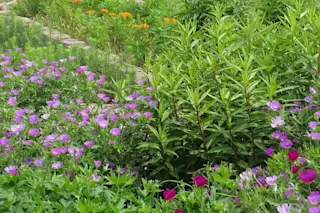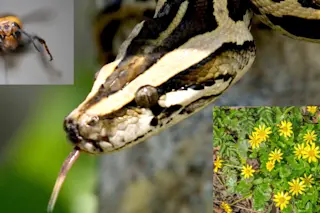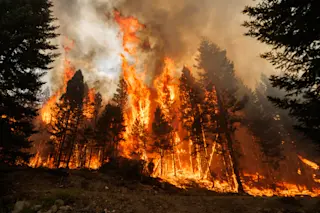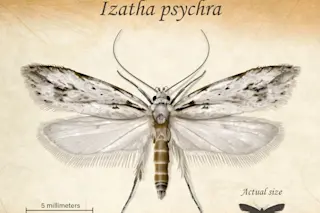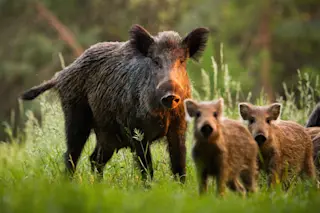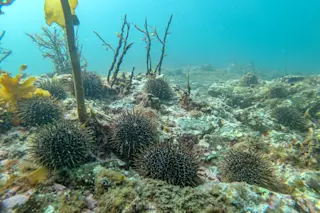Tamarisk trees are changing the Western landscape--drying up rivers and choking off native trees. Can beavers and bugs put a stop to all that?
The Colorado River gorge, flanked by towering cliffs and buttes and bisected by deep canyons, is quintessentially American scenery. Not so the thick vegetation that clings to the banks of the meandering river, in defiance of the desert it cuts through. In many places this luxuriant greenery consists almost entirely of tamarisk trees--which are native not to the American West but to the Mediterranean region and Asia. In the two centuries or more since they were introduced to the West, first as ornamental plants and later as a means of stabilizing stream banks, tamarisks have spread like wildfire. They have colonized at least a million acres of riverbank in Utah, Colorado, Arizona, New Mexico, and Wyoming. With their voracious appetite for water, they have sucked streams and oases dry; growing in dense thickets, they have gone far beyond stabilizing riverbanks and have narrowed the channels, stranding native cottonwood trees and willows far from their water source. Almost everywhere they’ve spread, they’ve replaced the indigenous species.
The struggle against the invaders is not yet lost, however, and recent research offers reasons for hope. One reason is beavers: they’re on their way back in the West, after being decimated in the last century by trappers, and a study of a stream in Colorado suggests that the beavers there are hindering the spread of tamarisks. The other reason is bugs. A study of insects imported from Israel and China has shown them to be eager feeders on tamarisks. The researchers who did that study are hoping to release the insects in the wild soon to see what they can do.
To be sure, not all ecologists agree that tamarisks are uniformly bad. At the bottom of the Grand Canyon, for instance, tamarisks now thrive where once there was next to no vegetation. According to river ecologist Lawrence Stevens, a consultant to the Bureau of Reclamation in Flagstaff, Arizona, the trees have been a boon there, providing habitat for a variety of birds, lizards, and insects. Among the birds that nest in tamarisks, Stevens says, is the southwestern willow flycatcher--which was placed on the endangered species list just last year.
But most ecologists see tamarisks as unwelcome, destructive pests. Stevens’s observations notwithstanding, the trees are generally considered biological deserts precisely because in most places they make life difficult for animals and other plants. The problem begins with insects. In their native habitat, tamarisks are controlled by various insects that feed on their leaves and sap. But only one of those natural enemies made the jump to the United States when the tree did: a rather ineffectual leafhopper that on rare occasions has been known to defoliate an isolated tree. Most native insects avoid tamarisks, according to ecologist Jayne Belnap of the National Biological Service in Moab, Utah. To survive in arid areas where the groundwater is saline, tamarisks have evolved the ability to get rid of salt by pumping it out onto their leaves. (Another name for the tree is salt cedar.) The salt-encrusted leaves keep most bugs away.
The tamarisk’s lack of insect predators does not just help it spread; along with its lack of edible seeds or fruits, it makes the tree unattractive to birds. Animals such as deer and antelope also shun tamarisk thickets, which block their access to the river and may conceal predators. Native plants, meanwhile, have difficulty competing with the tamarisk for water; they cannot grow in its dark shade; and their seeds cannot germinate in its thick, salty leaf litter.
The tamarisk has basically replaced entire native communities, says Belnap. But it doesn’t actually push other trees out. What it does is sit there and wait for a disturbance--such as a fire or a flood that wipes the other ones out. Then the tamarisk just takes over because it’s much better at colonizing. It produces millions of extremely small seeds, and it’s also a stump sprouter, so when it burns, it just doesn’t care at all. If there’s even just a piece lying around, the stuff will sprout and grow. Tamarisk trees have actually increased the incidence of fire along the Colorado because their leaf litter is abundant and especially flammable. You’ve got a river corridor that never burned before, and suddenly we have these massive fires sweeping through every year, she says.
In short, the tamarisk has mounted a blitzkrieg against the Colorado River ecosystem. We hate it, says Belnap. I’ve been trying to get people interested in making tamarisk furniture.
As it happens, something is using tamarisk as a construction material--not for furniture but for lodges and dams--at least along one creek in Colorado. Beavers had all but vanished from the region by the end of the last century, but since the 1950s, when they were deliberately reintroduced, their numbers have been growing again. And according to Bruce Baker, a wildlife biologist with the National Biological Service in Fort Collins, Colorado, the beavers in a Colorado River tributary called Douglas Creek are building dams from tamarisk. In doing so, they may be making the riverbank environment more favorable for willows, and for all the insects and birds that go with willows.
It is not so much that the beavers are having a direct impact on the tamarisk population; the gnawed trees readily resprout from their stumps. It is the dams that are changing the environment. When beaver dams vanished from Douglas Creek, says Baker, the spring floods produced by melting snow no longer overflowed onto the banks but instead rushed through the creek at high speed, cutting the bed deeper and making the banks drier. By late summer the streambed itself was dry--a disaster for willows, which need a constant water supply, but not for the tamarisk, a desert plant that can survive longer dry periods.
Now that the beaver dams are back, says Baker, they are trapping water that stays around all summer. The dams create a floodplain that acts like a sponge, Baker explains, so that the soil soaks up the water in the spring and then releases it slowly throughout the summer. In the wetter areas, the willow is now outcompeting the tamarisk.
While the beavers help the willows make it through the summer, the willows help the beavers make it through the winter. Unlike tamarisk wood--which beavers do not eat--willow sticks can be stored in a winter food cache beneath the frozen surface of a beaver pond. The result, says Baker, is a positive feedback: The more beavers, the more beaver dams. More dams create a better habitat for willow. That creates an overwinter food supply, which allows more beavers. So now more beavers can move into areas that don’t have willow. They’ll live on herbaceous aquatic vegetation during the summer and use tamarisks to build dams. And those dams will mean more willow.
Or so Baker hopes. Although beavers will not eliminate the tamarisk, he says, they may help control it. He also stresses that the positive feedback he envisions is still only a hypothesis, even at Douglas Creek. It’s even less clear what effect the return of beavers will have elsewhere along the Colorado. Although they’re known to be building with tamarisks in other creeks, they’re unlikely to be a panacea.
What could be? Herbicides are too risky; they’d be likely to do more damage to the less hardy native plants than to tamarisks. The best solution, researchers agree, is biological control--attacking the invader with its natural predators. At the U.S. Department of Agriculture in Temple, Texas, entomologist Jack DeLoach has conducted biological-control tests using insects that feed on the tamarisk in its vast native habitat. Our philosophy is to find out where the invading weed came from and go back there to find out what controls it, says DeLoach. Through cooperation with foreign research institutes, DeLoach has turned up two especially promising attack bugs: a Chinese leaf beetle and a mealybug that feeds on tamarisks growing on the shores of the Dead Sea in Israel.
In experiments conducted in a quarantine greenhouse, DeLoach and his colleagues have found both insects to be very damaging to tamarisks. The mealybug, a sap feeder, reproduced on the test plants, and the second generation of bugs actually killed about a third of them. The leaf beetle, says DeLoach, feeds on tamarisk leaves, and it is so destructive in China that the government there has had to apply insecticides to tamarisk trees that it has planted to stabilize dunes in the Taklimakan Desert. Most important, neither insect feeds on willows or cottonwood trees. They don’t feed on anything except the genus Tamarix, says DeLoach. So they’re very, very safe.
They’re safe, that is, unless you think Tamarix is a good thing to have around. Right now there is one obstacle blocking DeLoach from releasing his bugs: the southwestern willow flycatcher. Good studies have shown conclusively that the tamarisk is very harmful to most of the native bird species, says DeLoach. But there are some species that can nest in it and find food someplace else. And there are certain people who are afraid that if the tamarisk is controlled, maybe this soil is too salty and maybe the willow trees won’t come back, and that might in the end be somewhat destructive to this endangered southwestern flycatcher.
DeLoach and his colleagues are now trying to assess the environmental impact of their plan on the flycatcher. If they can convince the regulators, they may be able to release their tamarisk-eating insects as early as this summer. In the southwestern desert, says DeLoach, the streams and the shores of lakes provide the best habitat for most of the vegetation. The willow trees and the cottonwoods and several other species are a beautiful habitat for nearly all the birds and mammals. It’s a place where there’s water, and it’s a place where they can build their nests and breed. The tamarisk has almost destroyed a good part of this.
So we hope to control the tamarisk--not eradicate it. We don’t even want to do that. We would probably hope to reduce the abundance of tamarisks by about 80 percent. In the end it would be a component of the natural community--and you’d have a beautiful ecosystem again.



